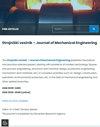Analysis of the Influence of Laser Power on the Microstructure and Properties of a Titanium Alloy-Reinforced Boron Carbide Matrix Composite (Ti6Al4V-B4C)
IF 1.2
4区 工程技术
Q3 ENGINEERING, MECHANICAL
Strojniski Vestnik-Journal of Mechanical Engineering
Pub Date : 2017-06-06
DOI:10.5545/SV-JME.2016.4159
引用次数: 6
Abstract
Laser Metal Deposition (LMD) process is a means of producing metal composites with the aid of a laser beam, ejected onto the substrate with the participating powder and fused together after solidification. In this research work, Ti6Al4V alloy is fused with 20 wt % of B4C in order to form metal matrix composites (MMCs). Using the Ytterbium Fibre Laser System powdered at 3000 W, the laser powers were varied between 800 W and 2400 W while all other supporting process parameters were kept constant. The deposited Ti6Al4V-B4C composites were characterized through the surfacing microstructure, microhardness and dry sliding wear. The microstructural properties of the deposited samples were profound, with a Widmanstatten structure of α-Ti, β-Ti and (α+β) Ti phases. The microhardness tests revealed that the composites deposited with a laser power of 2000 W exhibited the highest hardness value and standard deviation of HV 445 ± 61. Furthermore, characterisation revealed that the sample produced with the laser power of 800 W had the lowest wear loss and wear rate of 35.2 × 10–3 mm3 and 6.42 × 10-4 mm3/Nm. However, the motivation for this work is to improve the material properties of the Ti6Al4V alloy for surface engineering applications.激光功率对钛合金增强碳化硼基复合材料(Ti6Al4V-B4C)组织性能的影响分析
激光金属沉积(LMD)工艺是一种利用激光束将金属复合材料与参与粉末一起喷射到基材上,凝固后熔合在一起的方法。在本研究中,Ti6Al4V合金与20%的B4C熔合形成金属基复合材料(mmc)。采用3000w粉末化的镱光纤激光系统,在其他辅助工艺参数保持不变的情况下,激光功率在800w ~ 2400w之间变化。通过堆焊组织、显微硬度和干滑动磨损对沉积Ti6Al4V-B4C复合材料进行表征。沉积样品的显微组织性能较好,具有α-Ti、β-Ti和(α+β) Ti相的Widmanstatten结构。显微硬度测试表明,当激光功率为2000 W时,复合材料的硬度值最高,标准偏差为HV 445±61。此外,表征表明,在800 W激光功率下产生的样品具有最低的磨损损失和磨损率,分别为35.2 × 10-3 mm3和6.42 × 10-4 mm3/Nm。然而,这项工作的动机是为了改善表面工程应用的Ti6Al4V合金的材料性能。
本文章由计算机程序翻译,如有差异,请以英文原文为准。
求助全文
约1分钟内获得全文
求助全文
来源期刊
CiteScore
3.00
自引率
17.60%
发文量
56
审稿时长
4.1 months
期刊介绍:
The international journal publishes original and (mini)review articles covering the concepts of materials science, mechanics, kinematics, thermodynamics, energy and environment, mechatronics and robotics, fluid mechanics, tribology, cybernetics, industrial engineering and structural analysis.
The journal follows new trends and progress proven practice in the mechanical engineering and also in the closely related sciences as are electrical, civil and process engineering, medicine, microbiology, ecology, agriculture, transport systems, aviation, and others, thus creating a unique forum for interdisciplinary or multidisciplinary dialogue.

 求助内容:
求助内容: 应助结果提醒方式:
应助结果提醒方式:


